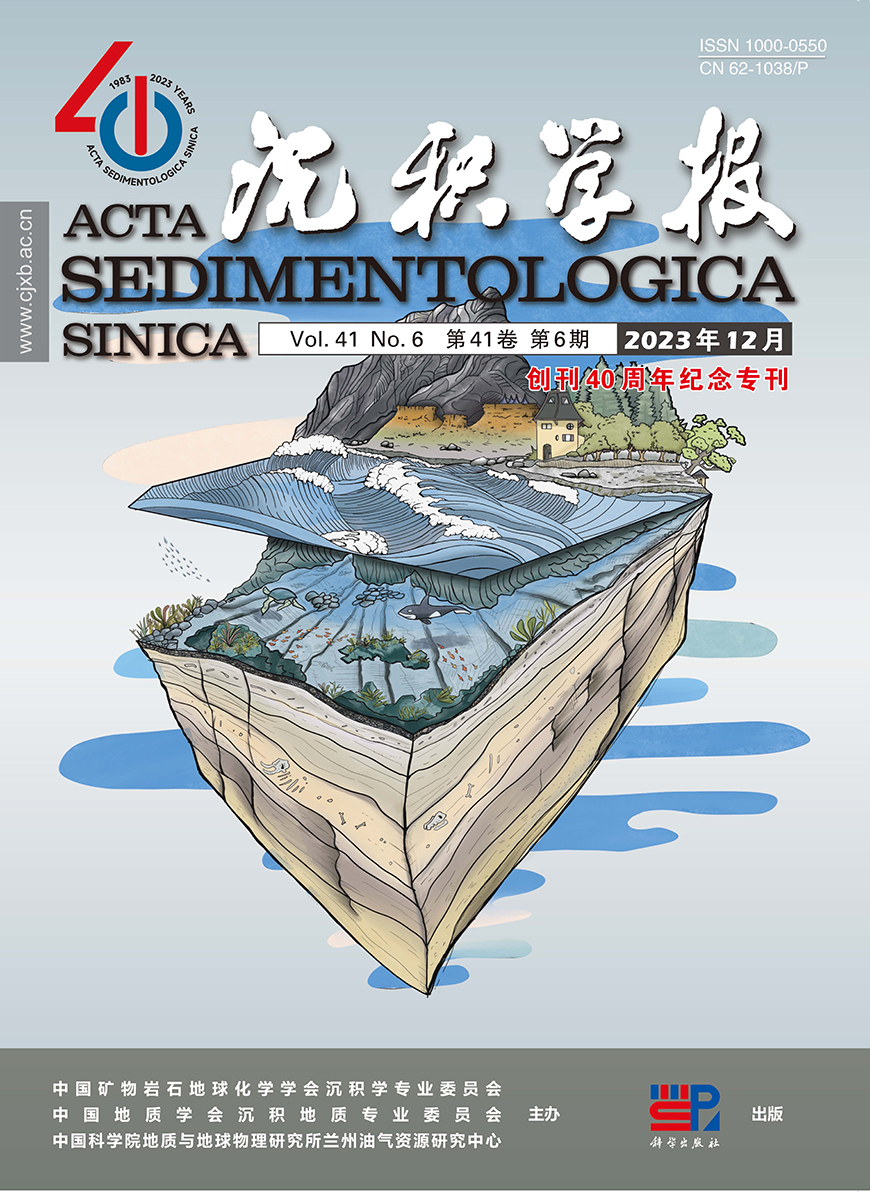HTML
-
依据板块构造理论,按照岩石圈板块之间的扩张作用、俯冲作用和剪切作用可将大陆边缘分别划分为被动陆缘、活动陆缘和转换陆缘[1⁃2]。相较于被动陆缘和活动陆缘,转换陆缘分布相对较少,约占全球大陆边缘面积的16%,而且其发现时间也较晚[3⁃4]。在Wilson[1]识别发现转换断层的基础上,Fail et al.[5]研究指出转换断层向陆延伸到大陆边缘则形成转换陆缘,随后Mascle[6]首次提出转换陆缘是与被动陆缘和活动陆缘并列的第三种大陆边缘类型。如图1a所示,圣保罗(St. Paul)断裂带、罗曼彻(Romanche)断裂带和Chain断裂带走向与板块裂离方向相同,以连接错断的南大西洋赤道段洋中脊为主要特征,为典型转换断层[7]。这些转换断层由洋中脊向陆延伸至大西洋赤道段大陆边缘形成转换陆缘,这些转换陆缘往往与被动陆缘相邻出现(图1)[4,7]。

Figure 1. (a) Regional map showing the geological background of transform and passive margin segments from the Equatorial Atlantic Ocean; (b) regional map illustrating the plane⁃view locations of attribute maps and regional seismic profiles
20世纪末大洋钻探计划159航次(ODP 159)针对转换陆缘进行了科学钻探和系列研究,而后转换陆缘相关研究才正式开展起来[8]。目前,研究最为系统的转换陆缘来自大西洋赤道段两岸,非洲板块和南美洲岩石圈板块在圣保罗、罗曼彻和Chain转换断层走滑作用下,在赤道大西洋形成一“转换陆缘域”[7]。沿顺时针方向,赤道大西洋转换陆缘域依次为非洲西海岸的塞拉利昂(Sierra Leone)转换陆缘、利比里亚—象牙海岸(Liberia-Ivory Coast)转换陆缘、象牙海岸—加纳(Ivory Coast-Ghana)转换陆缘,以及南美洲东海岸的菩提瓜尔(Potiguar)转换陆缘、巴雷里尼亚斯(Barreirinhas)转换陆缘和圣保罗(St. Paul)转换陆缘;本文的研究区位于赤道大西洋菩提瓜尔转换陆缘(图1)[7,9]。
近年来,随着转换陆缘上一系列重大油气勘探的发现(如科特迪瓦盆地、圭亚那盆地和东非鲁伍马盆地等),转换陆缘海底扇的沉积特征和沉积模式等相关研究引起学术界和工业界的广泛关注[2⁃4,10⁃12]。埃克森美孚公司(ExxonMobil Corporation)更是将“转换陆缘海底扇”与“巴西盐下碳酸盐岩、东非陆缘海底扇、挪威陆缘和墨西哥湾深水扇以及东地中海生物礁等”并列为当前油气勘探突破的重点领域。由于转换陆缘的相关研究较为薄弱,相较于经典海底扇沉积模式,关于转换陆缘海底扇沉积特征与沉积模式的研究也极不充分[2,4]。
本文利用赤道大西洋转换陆缘菩提瓜尔盆地采集的1 200 km2三维地震资料(图1),采用PaleoScan全三维智能解释手段和三色(RGB)混相分频技术精细刻画漂移晚期海底扇的沉积构成,在转换陆缘地貌特征分析的基础上建立了菩提瓜尔转换陆缘海底扇沉积模式。
-
赤道大西洋转换陆缘域的菩提瓜尔盆地总面积约4.8×104 km2,由陆上和海上两个部分组成,其中陆上面积约2.15×104 km2,海上面积约2.65×104 km2;此次研究区来自菩提瓜尔盆地的海上部分(图1)[13]。
在构造演化上,菩提瓜尔盆地受内陆张裂作用与沿罗曼彻和Chain两大转换断裂带形成的剪切作用的共同影响,经历了“裂谷期、转换期和漂移期”的构造演化过程[14⁃15]。在裂谷期,菩提瓜尔盆地以地壳伸展减薄导致强烈裂陷为主要特征,相应形成一系列不对称的地堑或半地堑[14⁃15]。在转换期,菩提瓜尔盆地的构造活动急剧减弱,构造沉降速率由陆向海不断增加[14]。漂移期可进一步划分为漂移早期和漂移晚期,在此期间,岩石圈冷却、菩提瓜尔盆地的构造活动基本终止,演化为被动陆缘阶段[14⁃15]。
与三期构造演化相对应,菩提瓜尔陆缘沉积充填由“裂谷层序、转换层序和漂移层序”组成;它们被如图2a所示的T10、T20和T30三个不整合面所分隔。菩提瓜尔陆缘裂谷层序主要发育Pendência组与Pescada组两套地层,以湖相、河流三角洲和扇三角洲沉积为主。转换层序主要由Alagamar组组成,发育河流三角洲、海相页岩和泥灰岩[16]。菩提瓜尔陆缘漂移早期层序主要发育Quebradas组,以海相页岩和重力流沉积为主;而菩提瓜尔陆缘漂移晚期层序主要发育Ubarana组,整体上以重力流沉积为主[16]。本文的研究目的层为菩提瓜尔陆缘漂移晚期发育的Ubarana组,其以T30为底界面;Ubarana组内部发育不整合面T31,界面之下大规模侵蚀下切特征明显,界面之上侵蚀下切规模有所减小(图2)。

Figure 2. (a) Regional seismic line (see Fig. 1a for line location) illustrating cross⁃sectional appearance of sedimentary successions of the Potiguar margin; (b) regional seismic transect showing cross⁃section view of horizon stacks of the Ubarana Formation in the Potiguar margin (i.e., the study interval of interest)
-
本文研究主要基于菩提瓜尔陆缘的高分辨率三维(3D)地震资料;3D地震数据的面积约1 200 km2,覆盖水深介于20~2 100 m。所使用的3D地震资料为深度域,地震资料的处理面元为18.75 m × 12.5 m。地震资料的采样间隔为5 m,以SEG负极性显示,在这样的剖面上正反射系数对应波阻抗的增加,对应地震反射剖面上的波谷(图2)。
主要采用剖面地震地层学和平面地震地貌学相结合的手段来识别菩提瓜尔盆地漂移晚期海底扇的沉积构成和形态特征[17⁃18]。地震地层学分析主要依据地震相的反射外形、反射参数和反射结构来识别地震相;而平面地震地貌学主要依据平面地震属性和外部形态(朵状、条带状和舌状等)[17⁃18]。主要使用三色(RGB)混相分频属性和均方根振幅(RMS)属性来识别菩提瓜尔盆地漂移晚期海底扇的沉积构成。均方根振幅是将振幅平方的平均值开平方,故其对强振幅较敏感,常常用于对富砂沉积体(如水道充填)的雕刻。三色(RGB)混相分频属性是利用时频变换算法对原始地震数据进行分频处理,得到低(5 Hz)、中(20 Hz)和高(35 Hz)三个单频数据体,并对这三个单频数据体赋以红(R)、绿(G)和蓝(B)三色;继而在所形成的具有通频信息的三色数据体上进行富砂沉积单元的识别和雕刻。
三色(RGB)混相分频属性和均方根振幅(RMS)属性的提取是依托PaleoScan全三维智能解释平台完成的,属性提取的时间窗统一设置为默认值7 ms。具体来说,手动识别并闭合解释漂移晚期Ubarana组底界面T30、顶界面海底和内部不整合面T31,这三个层位解释精度为937.5 m × 625 m。在此基础上,利用PaleoScan软件在目标水道顶底界面之间定义200个层位,并进行自动追踪、制作相应的层位堆叠体(如图2b中的黄色层位)。利用PaleoScan智能解释软件,分别对第82张、第116张和第172张切片提取三色(RGB)混相分频属性和均方根振幅属性;这些属性用于刻画菩提瓜尔陆缘漂移晚期海底扇的沉积构成。
-
通过对赤道大西洋转换陆缘域现今陆架地貌的分析,发现巴雷里尼亚斯(Barreirinhas)转换陆缘的陆架宽度介于63~80 km,平均宽度为72 km;陆架坡度从0.04°到0.09°不一,平均坡度为0.06°。菩提瓜尔转换陆缘的陆架宽度介于30~60 km,平均宽度为43 km;陆架坡度从0.05°到0.13°不一,平均坡度为0.10°(图3)。

Figure 3. (a) Modern topographic profiles of the Barreirinhas and Potiguar transform margins; (b) shelf and slope morphometrics (widths and gradients) of the Barreirinhas and Potiguar transform margins
全球地貌统计数据表明被动陆缘的陆架平均宽度为88 km[19],是转换陆缘陆架宽度的1.5倍;被动陆缘的陆架平均坡度约为0.1°[19],是转换陆缘陆架坡度的1.3倍(图3)。
综上所述,与被动陆缘不同的是,以菩提瓜尔陆缘为代表的转换陆缘具有相对较小的陆架宽度,与被动陆缘相同的是,以菩提瓜尔陆缘为代表的转换陆缘具有相对平缓的陆架;转换陆缘整体上具有“窄且缓”的陆架地貌特征(图3)。
-
通过对赤道大西洋转换陆缘域现今陆坡地貌的分析,发现巴雷里尼亚斯(Barreirinhas)转换陆缘的陆坡宽度介于16~38 km,平均宽度为27 km;坡度从3.2°到7.0°不一,平均坡度为5.3°。菩提瓜尔转换陆缘的陆坡宽度介于10~30 km,平均宽度为23 km;坡度从4.0°到8.0°不一,平均坡度为5.4°(图3)。
全球地貌统计数据表明:被动陆缘的陆坡平均宽度为46 km[19],是转换陆缘陆坡宽度的1.8倍;被动陆缘的陆坡平均坡度约为4.0°[19],转换陆缘陆坡坡度是其1.3倍;全球活动陆缘的平均陆坡坡度约为5.0°,与转换陆缘的陆坡坡度大体相当。在如图3a所示的转换陆缘现今地貌剖面图上,转换陆缘在中下陆坡处往往发育一正向地形凸起;该凸起的高度从0.6 km到2.7 km不一,平均高度为1.8 km,这些正向凸起为转换陆缘上的海山或转换脊[7]。这些海山或转换脊是转换陆缘陆坡段所特有的地貌单元,其在全球转换陆缘上均发育存在[7,20⁃21]。
综上所述,与被动陆缘不同的是,以菩提瓜尔陆缘为代表的转换陆缘具有相对较小的陆坡宽度和较大的陆坡坡度;转换陆缘整体上具有“窄而陡,外缘见海山或边缘脊”的陆坡地貌特征(图3)。
3.1. 陆架地貌特征
3.2. 陆坡地貌特征
-
菩提瓜尔陆缘漂移晚期发育的海底扇由“深水水道和末端朵叶”两大沉积单元构成,它们与被动陆缘上发育出现的深水水道和末端朵叶具有差异的剖面形态和沉积构成特征。
-
在剖面上,深水水道以“U形或V形、强振幅—中低频—低连续、充填反射”为典型地震相特征(图4)。在形态上,单期水道复合体(channel complexes)宽度介于1 430~3 717 m,平均宽度为2 612 m;深度介于104~339 m,平均深度为196 m;宽深比介于7~30,平均为14。水道沉积体系的平均宽度约为5 000 m,深度可达950 m,具有窄且深的剖面形态特征(图4)。在沉积构成上,单期水道复合体两翼不发育天然堤,呈孤立的侵蚀下切状;部分水道沉积体系在整个漂移晚期连续发育,无明显的沉积间断(被“席状、弱振幅—中高频—高连续、平行亚平行的深海披覆泥”所分割)出现(图4)。

Figure 4. Depositional dip⁃view seismic lines (see Fig.1b for its plane⁃view location) illustrating cross⁃sectional seismic appearance of submarine channels developed during the late drift stage
在被动陆缘上,深水水道两翼往往被呈“楔状、弱振幅空白反射的”天然堤所“夹持”,整体上呈展翅翱翔海鸥的鸥翼状;且不同的深水水道往往被深海披覆泥所分隔,典型深水水道剖面地震相实例如Howlett et al.[22]、Posamentier et al.[23]以及龚承林等[24]所示。与这些经典深水水道相较,菩提瓜尔陆缘漂移晚期发育的深水水道在剖面上具有“两翼不发育天然堤,呈孤立下切状”以及“多期水道复合体连续无间断发育”两大特征(图4)。
-
在平面上,深水水道呈“宽窄不一的强振幅亮色(图5a、图6a、图7a)或暖色(图5b、图6b、图7b)条带”。这些强振幅亮色或暖色条带相对孤立,无伴生的天然堤或决口扇等沉积单元出现;平面弯曲度介于1.02~1.26,平均弯曲度为1.08,中值弯曲度为1.06。

Figure 5. Red⁃green⁃blue (abbreviated as RGB) spectral decomposition⁃attribute (a) and root mean square (RMS) amplitude attribute (b) maps (see Fig.2 for their plane⁃view locations) showing the seismic geomorphological appearance of submarine fans developed during the late⁃drift stage on the Potiguar margin

Figure 6. Red⁃green⁃blue (abbreviated as RGB) spectral decomposition⁃attribute (a) and RMS amplitude attribute (b) maps (see Fig.2 for their plane⁃view locations) showing the seismic geomorphological appearance of submarine fans developed during the late⁃drift stage on the Potiguar margin

Figure 7. Red⁃green⁃blue (abbreviated as RGB) spectral decomposition⁃attribute (a) and RMS amplitude attribute (b) maps (see Fig.2 for their plane⁃view locations) showing the seismic geomorphological appearance of submarine fans developed during the late⁃drift stage on the Potiguar margin
在被动陆缘上,深水水道的弯曲度往往从低弯度的顺直状到高弯度的蛇曲状均发育出现,典型深水水道平面地貌特征如Howlett et al.[22]、Posamentier et al.[23]以及龚承林等[24]所示;且两翼往往发生浊流的溢出或决口现象,从而形成漫溢扇、决口扇、沉积物波或天然堤等沉积单元[24⁃25]。与这些经典的深水水道不同的是,菩提瓜尔陆缘漂移晚期发育的深水水道在平面上具有“相对顺直或低弯曲度”以及“无溢岸或决口现象”两大特征(图5~7)。
-
在剖面上,末端朵叶以“席状、强振幅—中高频—高连续、平行亚平行反射”为典型地震相特征(图8)。这些中强振幅—中高频—高连续地震反射之间平行或亚平行;且往往出现在深水水道的末端(图8)。

Figure 8. Depositional dip⁃view (a) seismic profile and depositional strike⁃view (b) seismic transect (see Fig.1b for their plane⁃view locations) illustrating the cross⁃sectional seismic appearance of terminational lobes developed during the late⁃drift stage on the Potiguar margin
在被动陆缘上,典型的末端朵叶与本文所述的菩提瓜尔陆缘末端朵叶具有相同的剖面地震相特征,均表现为“席状、强振幅—中高频—高连续、平行亚平行反射”,末端朵叶典型剖面地震相特征如Howlett et al.[22]、Posamentier et al.[23]、龚承林等[24]和Doughty-Jones et al.[26]所示。这些末端朵叶往往被认为是:深水水道内浊流在水道—朵叶转换带处通常会经历“限定性→半限定性”的流体转换造成粗碎屑卸载堆积所形成的产物[23⁃24,27]。
-
在平面上,末端朵叶呈“扇状或叶状亮色强振幅(图5a、图6a、图7a)或暖色强均方根振幅属性(图5b、图6b、图7b)堆积体”,它们往往出现在前已述及的深水水道的“末端出口处”。这些扇状或叶状亮色混相分频属性(图5a、图6a、图7a)或暖色强均方根振幅属性(图5b、图6b、图7b)堆积体的面积介于16~90 km2,平均面积为39 km2,中值面积为32 km2。相较于典型的浊积朵叶[23⁃24,27],菩提瓜尔陆缘漂移晚期末端朵叶平面规模较小。
在被动陆缘上,伴随着深水水道内浊流在水道—朵叶转换带处由近至远地向盆地一侧流动,随着限定程度越来越弱导致流速也越来越低,从而在每一条深水水道的前方形成彼此相对孤立的末端朵叶[23⁃24,27]。与这些经典的末端朵叶不同的是,菩提瓜尔陆缘漂移晚期形成发育的末端朵叶往往在陆坡上呈多期汇聚状,部分朵叶具有“汇聚叠置”的特征(图5~7)。
4.1. 深水水道
4.1.1. 剖面地震相特征
4.1.2. 平面地貌相特征
4.2. 末端朵叶
4.2.1. 剖面地震相特征
4.2.2. 平面地貌相特征
-
以菩提瓜尔陆缘为代表的转换陆缘具有“窄缓陆架、窄陡陆坡”的地貌特征,这一转换陆缘特殊的地貌背景导致转换陆缘海底扇具有和被动陆缘海底扇不同的沉积模式。
-
前已述及,菩提瓜尔转换陆缘具有“窄缓”的陆架地貌特征,平均陆架宽约43 km(图3);这一陆架宽度与转换陆缘的平均陆架宽度(31 km)大体相当[19]。在窄缓的陆架地貌条件下,陆源碎屑在浅水陆架上的“驻留”时间往往较短、向深水中搬运输送已不再受到基准面变化的调控;从而导致粗碎屑颗粒既可以在基准面下降的下降体系域和低位体系域,也可以在基准面上升的海侵体系域和高位体系域向深水区搬运沉积[28]。窄陆架(陆架宽度小于50 km)使得粗碎屑颗粒向深水中搬运分散不受基准面变化控制,典型实例来自美国怀俄明州的Washakie盆地的Lewis陆缘,晚白垩纪Lewis陆缘的陆架宽度约为40~50 km;与菩提瓜尔转换陆缘漂移晚期一样,均具有典型的窄陆架特征[29]。在这一陆缘上,既在指示基准面下降的下行水退型陆架坡折迁移(坡折轨迹呈平坦—低角度下降状)前方发育出现海底扇,也在指示基准面上升的上行水进型陆架坡折迁移(坡折轨迹呈上升状)前方识别到海底扇[28⁃29]。
与晚白垩纪Lewis陆缘一样,窄陆架使得粗碎屑颗粒以重力流的方式,向漂移晚期菩提瓜尔转换陆缘深水区搬运分散形成海底扇的过程,不再受基准面变化的控制。换言之,海平面变化的任何时刻菩提瓜尔转换陆缘深水区均可能发育大规模的重力流及其所形成的海底扇,从而导致重力流及其所伴生的水道复合体在剖面上连续无间断发育、纵向上呈“连续叠置”状(图4)。在白垩纪几内亚转换陆缘上,“窄缓陆架地貌”背景下形成发育的海底扇具有与漂移晚期菩提瓜尔陆缘海底扇相同的剖面发育特征,均表现为“多期水道复合体连续叠置”的剖面发育模式[10,30]。
-
前已述及,菩提瓜尔转换陆缘具有“较陡”的陆坡地貌特征,平均陆坡坡度约5.4°(图3);这一陆坡坡度与全球活动陆缘的平均陆坡坡度(5.0°)大体相当[19]。前人研究表明:在较陡的陆坡地貌条件下,重力流往往具有较高的流速和较强的侵蚀能力[31]。如此“强劲”的重力流抑制了溢岸和决口现象的发生,从而使得菩提瓜尔转换陆缘漂移晚期发育的深水水道以“平面上相对顺直、剖面上两翼不发育天然堤”为主要特征(图4、图8a、图9)。与此同时,“无明显溢岸和决口现象”使得深水水道在沉积建造过程中以垂向上的生长为主,不易发生侧向摆动[32],导致水道—朵叶复合体的平面规模相对较小。

Figure 9. (a) Three⁃dimensional perspective view of RGB spectral decomposition⁃attribute map (see Fig.1b for its regional plane⁃view location) illustrating the plane⁃form geomorphological characteristics of submarine fans developed during the late drift stage on the Potiguar margin; (b) schematic illustration of submarine fans formed during the late drift stage on the Potiguar margin
此外,以漂移晚期菩提瓜尔陆缘为代表的转换陆缘具有较窄的陆坡地貌特征,且在中下陆坡处发育海山或转换脊[7,20⁃21]。海山或转换脊的存在对转换陆缘上的重力流起到了阻挡作用,从而使得朵叶在其前缘多期汇聚叠置,在平面表现为“裙边状”(图5~7、图9)。此外,陆坡较窄使得陆源物质越过陆架坡折向深水中搬运分散的距离较短,故转换陆缘上形成发育的海底扇的粒度往往偏粗[10]。在白垩纪几内亚转换陆缘上,“限定性的,陡窄陆坡地貌”背景下形成发育的海底扇与漂移晚期菩提瓜尔陆缘海底扇具有相同的平面发育特征,均表现为“单期平面规模较小、多期汇聚成裙边状”的平面发育模式[10,30]。
5.1. 剖面发育模式
5.2. 平面发育模式
-
本文以漂移晚期菩提瓜尔陆缘为例,分析了陆架和陆坡的地貌特征,识别了海底扇的沉积构成,进而揭示了海底扇的发育演化模式,取得的成果认识如下。
(1) 漂移晚期菩提瓜尔陆缘具有“窄缓”的陆架地貌特征和“窄陡,外缘见海山或边缘脊”的陆坡地貌特征。其中,陆架平均宽度为43 km,平均坡度约为0.1°;陆坡平均宽度为23 km,平均坡度约为5.4°。
(2) 菩提瓜尔陆缘漂移晚期海底扇主要由深水水道和末端朵叶两个亚相单元构成。在剖面上,深水水道两翼不发育天然堤,呈多期连续叠置状;而末端朵叶呈“席状、强振幅—高连续、平行亚平行反射”。在平面上,深水水道呈顺直状或低弯度状;而末端朵叶单期平面规模较小,多期汇聚成裙边状。
(3) 窄缓的陆架地貌使得陆源碎屑在基准面变化的任何时刻均可被搬运分散到深水陆坡区,从而导致重力流及其所伴生的水道复合体在剖面上连续无间断发育,呈多期连续叠置状。窄陡的陆坡地貌使得重力流往往具有较高的流速和较强的侵蚀能力、抑制了浊流的溢岸和决口现象,导致深水水道以垂向上的生长为主,所形成的单期水道—朵叶复合体平面规模往往较小;这些小规模的朵叶被海山或边缘脊所遮挡,导致多期朵叶往往汇聚叠置成裙边状。







 DownLoad:
DownLoad:







